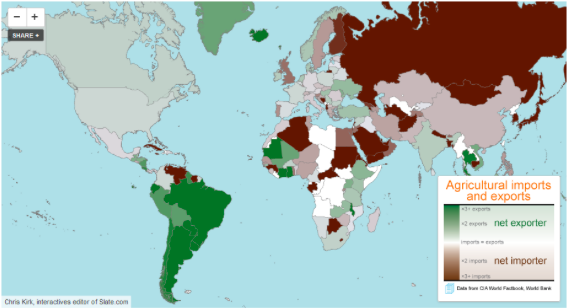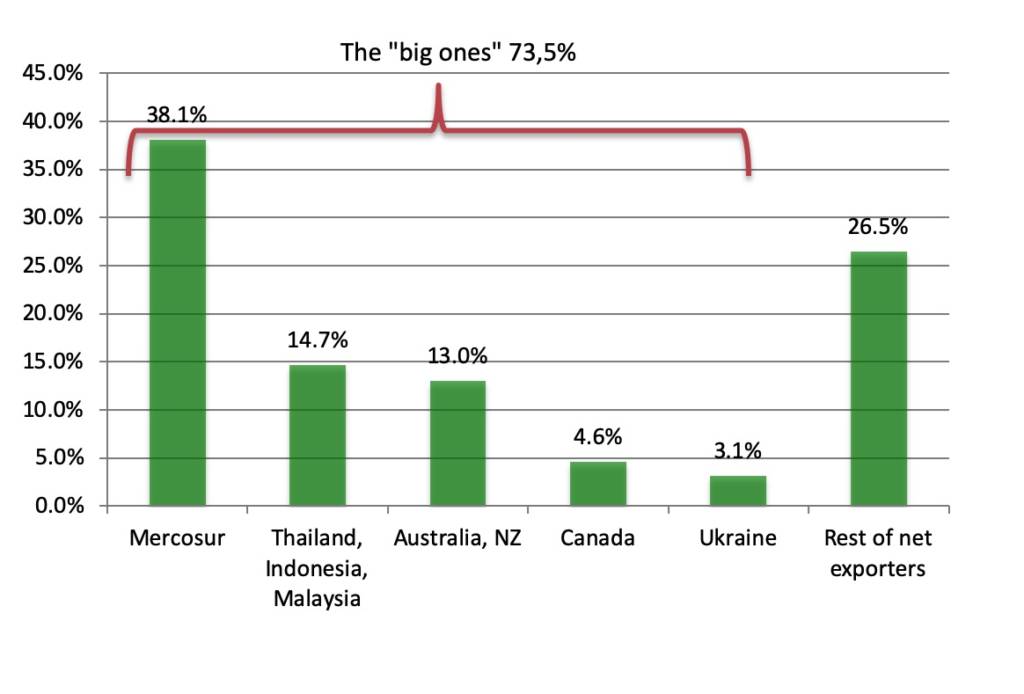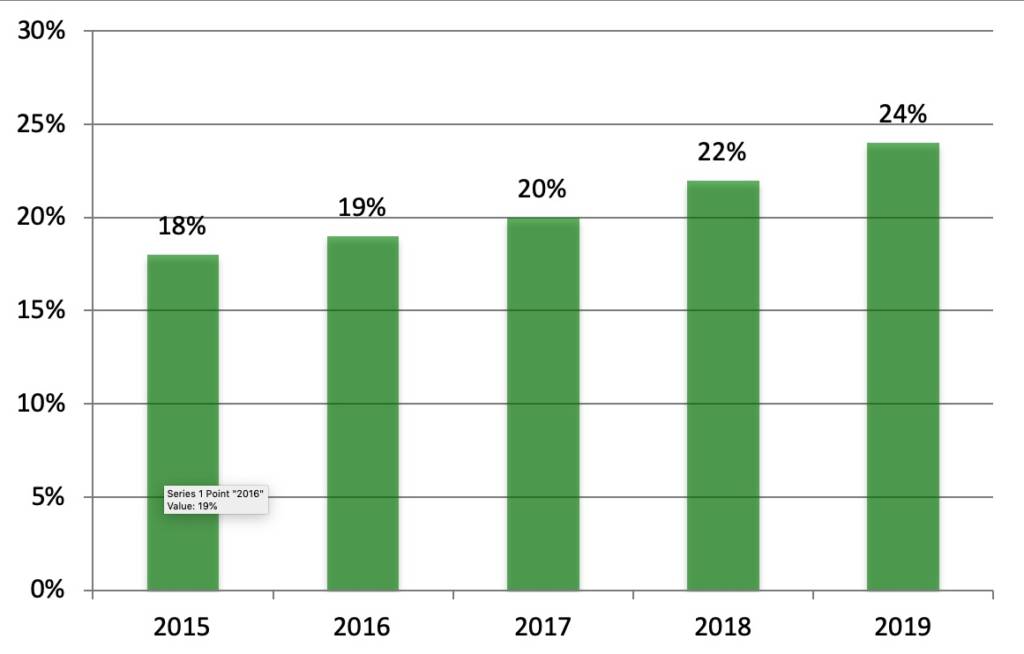This article is co-authored by: Ernesto Viglizzo[1], Pablo Elverdin[2] and Paloma Ochoa[3]
The Group of Producing Countries from the Southern Cone (GPS), is a network of private institutions from Argentina, Brazil, Paraguay and Uruguay, created in 2013, focused on regional integration and integration of the region to the world, in the field of Food Security.
Mercosur, in particular, and South America, as a whole, is the world’s first net food export region and represents 30% of the world market.
Introducing South America: 30% of the world’s food market
Figure 1. World net food exporters and importers

Source: www.slate.com
Given this important position in food production, GPS develops its task in three closely interrelated areas: i) Trade and investments in the agro-industrial sector; ii) The role of regional integration and the bioeconomy in the agro-industrial development; and iii) Climate change and sustainable development for food security. Additionally, given the increase in global uncertainty and commercial tensions, during the last year GPS has added a new working area in order to generate strategic thinking on the international insertion of the countries within the region: Geopolitics of food.
Since the beginning of the 21st century, world food security has become a major concern for world leaders. This presents a complex challenge since the world is supposed to produce more food using available resources in the most efficient way in order to reduce Greenhouse Gases (GHG) emissions and this impact on climate change.
Trade is crucial to cope with this challenge because of imbalances in regional production and consumption at world level. Mercosur countries have a high production growth potential, based on their endowment of natural resources and proven technological innovation and business models. According to the last OECD-FAO Agricultural Outlook 2019-2028, these countries are major exporters of soybeans, pork, maize, poultry, animal feed, sugar, coffee, and fruits and vegetables. Brazil is the largest agricultural and food exporter (USD 79.3 billion in 2017) in the region, followed by Argentina, (USD 35.0 billion) (OECD-FAO, 2019).
Figure 2. Main world food exporters (in USD)

Source: Elverdin (2019), base on Tradamap
Argentina and Brazil are the major cereal producers in the region, accounting for around half of total LAC coarse grain and rice production, 75.1% of total maize production, and 77.8% of wheat production (OECD-FAO, 2019).
Soybean production has been particularly dynamic in South America, especially in Argentina, Brazil and Paraguay where yield improvement on the basis of technological innovation has been accompanied by land expansion. These three countries currently account for 96.6% of total soybean production in the region (OECD-FAO, 2019).
Regarding meat, total exports increased 1,5% from 2017 to 2018, reaching 34 million tons.
China has become a key trade partner for the region. As a result of extensive trade complementarity, the region’s relative position in Chinese agri-food imports has grown at high rates over the past two decades. And this has increased in the last year as trade dispute between China and US led to replacement of US as supplier in some agricultural goods. For example, 2019 was a record year for Mercosur countries in terms both of production and export of meat. In particularly, driven by the porcine fever in China, beef exports from Mercosur countries achieved a record figure in 2019, growing 17% and reaching 2.700.000 tons. The participation as providers of beef has been increasing in the past years and the four countries are at present the main providers of beef, with 24% of the global supply.
Figure 3. Mercosur participation in global beef exports

Source: ROSGAN
Chinese affecting production
However, even if in the future what happens with Chinese consumption might affect production and export trends, it appears that pork and poultry will be the growing productions while beef will remain more as a specialty.
Regarding the relation between agroindustrial production and climate change, emissions from Argentina and Brazil –the two major extended countries in the Mercosur region of South America- account for about 1.99% (0.55% and 1.44% respectively) of global emissions. Of total emissions in both countries, approximately a half corresponds to emissions from the rural sector. China, US, EU and India account, on the other hand, for 57.11% of the planet’s total emissions. The comparison suggests that the South American contribution to global emissions is negligible.
Getting the balance right: tackling deforestation
However, GHG emissions from deforestation are still the main problem to be solved in the region. Although substantive progress has been made, certainly the region is globally blamed by this issue. After more than 15 years of reduction in the deforestation rate, 2018 and 2019 showed a growth in the number of deforested annual hectares in Brazil, although still shows less than half that evidenced until 2005. Deforestation in Brazil and Paraguay is strongly associated with livestock expansion. On the other hand, deforestation in Argentina was explained by the expansion of the soybean area until 2008. But soybean and deforestation were decoupled after 2008, and the rate of forest loss today in Argentina is about 25 % of the area that was lost one decade ago. There are today increasing regional pressures to reduce deforestation in Brazil and Paraguay.

Carbon sinks in South America
The role of grazing land as carbon sinks is underestimated in most South American countries. However, their contribution can be very relevant if we assume that grazing land covers a very important percentage (78-90 %) of national lands in Argentina, Paraguay, Uruguay, and Brazil (about 35%). According to a recent investigation, >80% of the total C sequestration in the rural sector could be attributed to grazing lands in Argentina, Paraguay and Uruguay. Something different is the case of Brazil where forests explain most of C sequestration in the country. However, because of the size of Brazil, the absolute contribution of Brazilian forests clearly exceeds the total capacity of grazing lands to sequester C in the other three countries.
Worldwide used IPCC guidelines assume that C gains and losses in most grazing lands are in equilibrium because carbon in soils is saturated and then sequestration is almost zero. However, as some authors argued, worldwide carbon saturation is unlikely under grazing conditions because soils subjected to frequent disturbance may never reach a saturated status. Findings in a recent research suggest that most grazing lands may be gaining more carbon than they lose and this may change the equation. The carbon balance in national GHG inventories may differ a lot depending on whether carbon sequestration in grazing lands is incorporated or not into calculations. Given that such fraction of sequestered carbon is probably undervalued, a thorough revision of methods to estimate the carbon balance is quite necessary in the coming years.
Forests are a major way to capture and store atmospheric carbon in South America, but trees and forests that are vulnerable to fire and drought can suffer a transition from carbon sinks to carbon sources resulting in large GHG emissions. On the other hand, grazing lands have the capacity to be more drought- and fire-resilient than forests, particularly in semiarid environments. Given the dominance of livestock systems evolving on grazing lands in Mercosur countries, they offer a significant potential to remove and store carbon in soils and contribute to mitigate global warming.
Moving forwards
Stopping
deforestation, promoting afforestation and managing grazing land are three
priority strategies to achieve a positive carbon balance in the long term.
Livestock production systems in South America should be revisited. There are
interesting iniciatives, such as Coalizao Brasil,[4]
the Argentine Carbon Neutral Program[5]
or Uruguay’s National Land Use and Management Plans[6]
that should be considered with attention. The Southern Cone region has,
undoubtly, the potential to become an even more relevant player towards a
sustainable approach that considers both food security and climate change as
central variables.
[1] Member of GPS Argentina Support Team. Consultant in environmental issues.
Agricultural engineer with a doctor’s degree from Louvain Catholic University in Belgium.
Principal Researcher at the CONICET, former researcher at INTA and professor at Universidad Austral. Leading author of IPCC (Intergovernmental Panel on Climate Change) reports and of reports on other governmental environmental programs. Corresponding Member of the National Academy of Agriculture and Veterinary Science, Honorary member of AACREA.
[2] GPS Strategy and content coordinator. Economist, member of the CEO Group. He is currently also an external consultant of the International Food Policy Research Institute –IFPRI-. His areas of research include economics, trade, food security and agroindustrial policy, and he has published many discussion papers and articles in recent years.
[3] Communications Coordinator of the Group of Producing Countries of the Southern Cone (GPS), Magister in International Trade Relations (UNTREF), Degree in International Relations and Political Science (USAL). Currently works as consultant, trainer, researcher and professor in the areas of business development, international trade, economic and production integration, global value chains and competitive intelligence.
[4] https://www.coalizaobr.com.br/
[5] https://bolsacer.org.ar/Fuentes/noticia.php?Id=1443
[6] https://www.presidencia.gub.uy/comunicacion/comunicacionnoticias/aguerre-cop21-paris-planes-uso-manejo-suelo

























